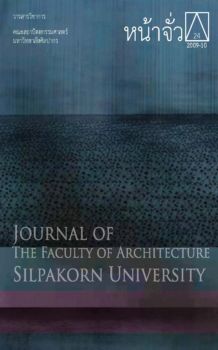การเสื่อมสภาพของพระพุทธรูปอันเนื่องมาจากเกลือ กรณีศึกษา: พระพุทธรูปในพระอุโบสถหลังเดิม วันอินทารามวรวิหาร กทม.
Keywords:
เกลือบนพระพุทธรูป, การเสื่อมสภาพเพราะเกลือ, ปูนหมักปูนตำ, ปูนขาว, การเสื่อมสภาพของปูน, salt crystallization, salt deterioration, salts on Buddha statues, lime, lime plaster, lime stuccoAbstract
บทความนี้เป็นผลการศึกษาวิจัยเกลือบนพระพุทธรูปองค์หนึ่งซึ่งประดิษฐานอยู่ในพระอุโบสถหลังเดิมของวัดอินทารามวรวิหาร แขวงบางยี่เรือ เขตธนบุรี กรุงเทพมหานคร จากการศึกษาและวิเคราะห์องค์ประกอบทางเคมีของปูนปั้นและปูนฉาบขององค์พระและปูนฉาบฐานชุกชีด้วยเครื่อง X-ray Diffractometer (XRD) พบว่าทำมาจากปูนหมักปูนตำ ซึ่งเมื่อแข็งตัวแล้วจะมีองค์ประกอบหลักคือแคลเซียมคาร์บอเนตและแร่ควอทซ์ โดยที่ไม่มีเกลือซัลเฟตซึ่งเป็นส่วนประกอบของปูนซีเมนต์ปะปนอยู่เลย และผลการวิเคราะห์ผลึกเกลือที่เกิดขึ้นบนองค์พระด้วยเครื่อง XRD พบว่าเป็นเกลือโซเดียมไนเตรทและเกลือโซเดียมคลอไรด์ซึ่งไม่ได้มาจากดิน เพราะจากการวิเคราะห์องค์ประกอบทางเคมีของดินพบว่าไม่มีเกลือไนเตรทหรือคลอไรด์ปะปนอยู่ เกลือไนเตรทที่พบสันนิษฐานว่า อาจละลายมากับน้ำฝนที่ชะล้างมูลของนกและค้างคาวซึ่งอยู่บนหลังคาของพระอุโบสถซึ่งรั่วแล้วหยดลงบนองค์พระ หรือมาจากน้ำที่ชะล้างเกลือไนเตรทที่เกิดจากการย่อยสลายเศษอาหารชองชุมชนในบริเวณใกล้เคียงแล้วซึมเข้าสู่องค์พระ ส่วนเกลือโซเดียมคลอไรด์ที่พบอาจปนเปื้อนมาในวัสดุที่ใช้ก่อสร้างองค์พระตั้งแต่แรกเริ่ม หรือปนมากับเนื้อองค์พระพุทธรูปด้านในหรือวัสดุโครงสร้างของฐานชุกชีซึ่งไม่สามารถตรวจสอบได้ หรืออาจปนมากับนํ้าใต้ดินในรูปเกลือคลอไรด์ หรือมาจากนํ้าทิ้งที่ชะล้างเศษอาหารที่มีเกลือแกงที่ใช้ปรุงอาหารของคนในชุมชนปะปนอยู่แล้วซึมเข้าสู่องค์พระ ซึ่งวัดในชุมชนส่วนใหญ่จะพบเกลือไนเตรทและเกลือคลอไรด์ปะปนมาด้วยเสมอ และผลการศึกษาสรุปได้ว่าเกลือเป็นสาเหตุหลักที่ทำให้พระพุทธรูปองค์นี้เสื่อมสภาพ เนื่องจากรูปแบบของการเสื่อมสภาพขององค์พระเป็นรูปแบบเดียวกับการเสื่อมสภาพของวัสดุอันเนื่องมาจากเกลือ รวมไปถึงการที่พบผลึกเกลือบนผิวของทั้งปูนฉาบและปูนปั้นองค์พระและพบเม็ดเกลือปะปนอยู่ในปูนปั้นองค์พระในฤดูแล้งหายไปในฤดูฝนแล้วกลับมาใหม่ในฤดูแล้งต่อมา เป็นหลักฐานแสดงการเสื่อมสภาพของพระพุทธรูปองค์นี้อันเนื่องมาจากการตกผลึกซํ้าๆ ของเกลืออย่างชัดเจน
The Deterioration of Buddha Statues Caused by Salts Case Study: A Buddha Statue in the Former Ubosot of the Intaram Voravihara Temple, Bangkok
Nuanlak Watsantachad, Ph.D.
Faculty of Architecture, Silpakorn University
This article is the result of a research project on efflorescence on Buddha statues. A field survey and several chemical analyses with XRD on materials of and salts deposited on a Buddha statue, located in the former Ubosot of the Intaram Voravihara Temple in Bangkok, shows that this statue is made of lime and the salts are sodium nitrate and sodium chloride. The materials are composed of calcium carbonate and silicon dioxide, and no sulphate, which is normally found in cements, is detected. The result confirms that the materials are lime and no cements were used in previous conservations of the statue and its base. According to the chemical analysis, the surrounding soil contains neither nitrate nor chloride;hence, the efflorescence on the statue does not come from the soil. The nitrate might come from the rain that washed out birds’ and bats’ increments on and under the leaking roof of the Ubosot and thereafter dropped onto the Buddha
statue. Sodium chloride might originally contaminate in the lime stucco or in materials used at the statue’s core or base which could not be analyzed in this research. These two salts might be dissolved by groundwater and absorbed to the statue by capillary action. The study could be summarized that the deterioration of the statue is mainly caused by salt crystallization since it has the same patterns of deterioration as those of salt deterioration. These patterns include crumbling, blistering, foliation and plaster detachment. Cycles of salt crystallization, during wet and dry seasons, on and within the Buddha statue could confirm that it is deteriorated by salts.





